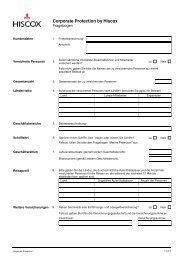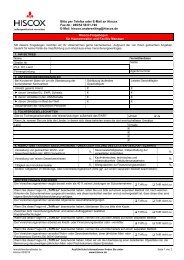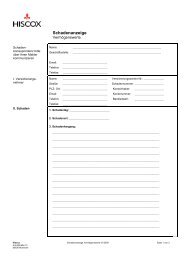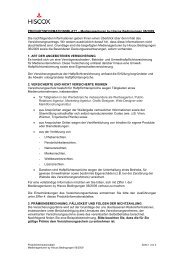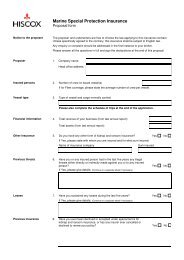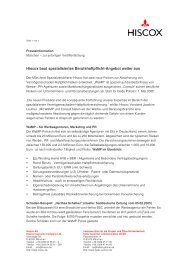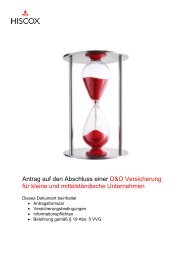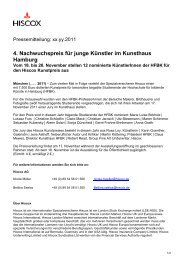Download PDF - Hiscox
Download PDF - Hiscox
Download PDF - Hiscox
You also want an ePaper? Increase the reach of your titles
YUMPU automatically turns print PDFs into web optimized ePapers that Google loves.
Credit<br />
Reinsurance counterparties<br />
The Group purchases reinsurance protection<br />
to limit its exposure to single claims and the<br />
aggregation of claims from catastrophic<br />
events. The Group places reinsurance with<br />
companies that it believes are strong financially<br />
and operationally. Credit exposures to these<br />
companies are closely managed by the<br />
Reinsurance Security Committee (RSC),<br />
which is chaired by the Group Finance Director.<br />
All reinsurers used must be approved by the<br />
RSC following an internal assessment of the<br />
company’s financial strength, trading record,<br />
payment history, outlook and organisational<br />
structure, in addition to credit ratings granted<br />
by external agents. Approved reinsurers are<br />
monitored continuously to identify potential<br />
deteriorations as early as possible. Monitoring<br />
procedures include consideration of public<br />
information produced by reinsurers; the Group’s<br />
experience of the reinsurers and their behaviour<br />
in the marketplace; and analysis from external<br />
consultants and from rating agencies. Credit<br />
limits are set for approved reinsurers both at<br />
a <strong>Hiscox</strong> Group level and for each underwriting<br />
subsidiary based on a defined risk appetite. The<br />
Group’s experience of bad debts arising from<br />
its reinsurance arrangements has been minimal.<br />
Operational and other key risks<br />
Business continuity<br />
The Group has taken significant steps to<br />
minimise the impact of business interruption<br />
that could result from a major external event.<br />
A formal disaster recovery plan is in place<br />
for both workspace recovery and retrieval<br />
of communications, IT systems and data.<br />
In the event of a major event, these procedures<br />
will enable the Group to move the affected<br />
operations to alternative facilities within very<br />
short periods of time. The disaster recovery<br />
plan is tested regularly and includes disaster<br />
simulation tests. Staff are widely distributed<br />
throughout the UK, Europe, USA, Bermuda<br />
and Guernsey. This geographical dispersion<br />
reduces the Group’s exposure to natural or<br />
terrorist events that could prevent access to<br />
premises or loss of staff. In the event of a loss<br />
of staff, for example as a result of a pandemic,<br />
a plan is in place to re-assign key responsibilities<br />
and transfer resources to ensure key business<br />
functions can continue to operate.<br />
<strong>Hiscox</strong> credit rating<br />
The external ratings granted to the Group<br />
and its subsidiaries are essential to maintaining<br />
profitability, particularly in relation to our<br />
reinsurance business and managing the costs<br />
of financing and access to capital. We have<br />
identified the key aspects of our business<br />
which are critical to maintaining our ratings<br />
and closely manage these to minimise the risk<br />
of an event which might jeopardise any rating<br />
and to ensure that we respond appropriately<br />
to unforeseen external events. We maintain<br />
regular and open communication with our<br />
rating agencies to ensure that we continue<br />
to meet their expectations and that careful<br />
consideration is given to the potential impact<br />
on a rating of any significant decision.<br />
Emerging risks<br />
Being able to identify and plan for unexpected<br />
events has become an increasingly important<br />
component of our business cycle management.<br />
Emerging risk identification and control is<br />
therefore a core part of risk management activity<br />
in relation to all aspects of our business,<br />
including underwriting, operations and strategy.<br />
Significant efforts are made, including obtaining<br />
external expertise, to try to identify any threats<br />
to the business either actual or potential. For<br />
example, a change in US legislation may result<br />
in unintended risks being underwritten, or may<br />
require us to cease business in certain US<br />
states. The identification of emerging risks<br />
is a core agenda item in each Risk Committee.<br />
We take all reasonable steps to minimise the<br />
likelihood and impact of such events and<br />
to be prepared for their occurrence.<br />
Capital<br />
The Group manages capital rigorously in<br />
order to maximise its return on capital whilst<br />
maintaining sufficient levels of financial resources<br />
to absorb unexpected losses and meet the<br />
requirements of regulators and rating agencies.<br />
Accurate measurement of potential losses<br />
under various scenarios is a critical aspect of<br />
our business planning and capital management<br />
cycle. Potential losses are calculated regularly<br />
using the most sophisticated modelling<br />
techniques available supported by stress and<br />
scenario assessments. We invest heavily in the<br />
most up-to-date risk management techniques<br />
and in expert staff to ensure our procedures<br />
and analyses remain second to none.<br />
Investments and foreign exchange<br />
Investment policy<br />
The investment policy is designed to maximise<br />
returns within the overall risk appetite of the<br />
Group which stipulates a one in 100 year loss<br />
tolerance. The overriding philosophy with the<br />
Group’s assets is not to lose money or to put<br />
at risk the Group’s capacity to underwrite.<br />
Short-term interest rates are likely to remain<br />
at historically low levels throughout 2010.<br />
As a result the possibility of losing money with<br />
a portfolio consisting of any assets other than<br />
cash or short-term Government securities is<br />
statistically greater than normal. Consequently<br />
the Board has agreed, in current market<br />
conditions, to set aside extra capital to support<br />
the recommended asset allocation and to<br />
provide a buffer against possible investment<br />
losses during the year.<br />
Technical funds, the investments held for<br />
the payment of future claims, are primarily<br />
invested in high quality bonds and cash.<br />
Emerging risk<br />
identification<br />
and control is<br />
a core part of risk<br />
management<br />
activity in relation<br />
to all aspects of our<br />
business, including<br />
underwriting,<br />
operations and<br />
strategy.<br />
Risk management <strong>Hiscox</strong> Ltd Report and Accounts 2009<br />
23




